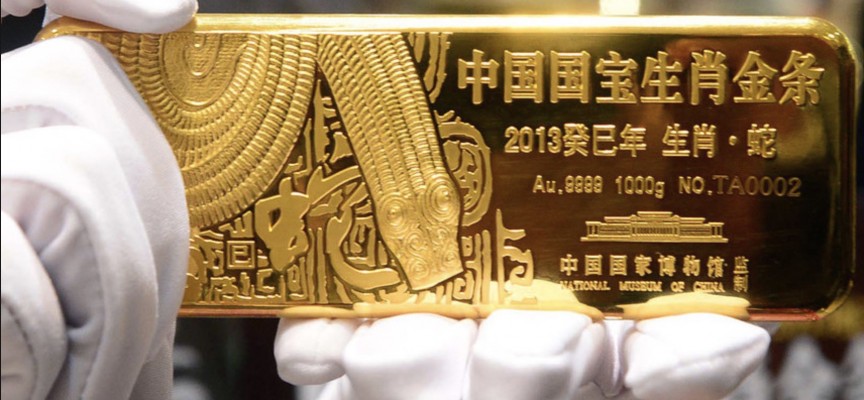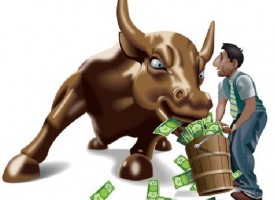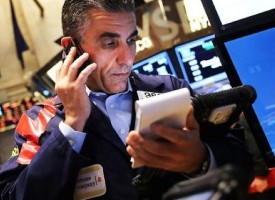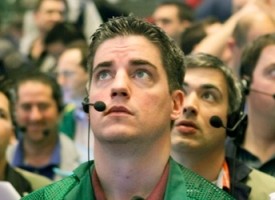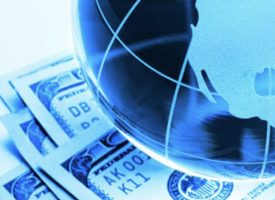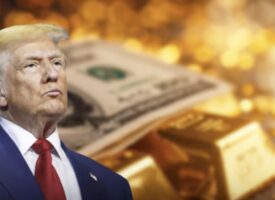As we approach the end of October in what has been a tough environment in the gold and silver markets, today a legend in the business sent King World News a powerful piece about the big picture and what will translate into a $100 spike in gold overnight.
Gold’s Surge To $1,600
By John Ing, Maison Placements
October 27 (King World News) – For almost two decades, these institutions manipulated rates for their own benefit. Is this the latest hedge fund rigging scandal? No, it’s the world’s leading central banks, including the Bank of Japan (BOJ) manipulating interest rates, after rounds and rounds of large scale quantitative easing (QE) that saw them buy up almost half of the Japanese ETFs. Yet despite manipulating the yield curve and creating money to buy assets like government debt and ETFs, there is growing concern they’ve reached their limit…
IMPORTANT:
To find out which high-grade silver mining company billionaire Eric Sprott just purchased
a nearly 20% stake in and learn why he believes this is one of the most
exciting silver stories in the world – CLICK HERE OR BELOW:
In amassing securities through quantitative easing programs, the central banks of Japan, US and UK balance sheets make up 40 percent of global GDP. Just as King Canute could not control the seas, setting interest rates underscores the central banks’ limitation. Now their ultra-low policies and even their existence are under attack. QE infinity has ended.
Even so, Japan had not one, but two lost decades and the unconventional policies have yet to revive their economy or inflation. Investors are increasingly skeptical over Japan’s multiple forms of easing and rather than go down, the yen gained 20 percent. Having exhausted other policy options, the BOJ promised to keep ten-year government bond yields at zero. The Japanese were among the first to introduce quantitative easing with huge increases in bond purchases by its post office.
For a time, this worked yet somehow, the two percent inflation target was missed. So each time, a new inflation target was created and subsequently, negative rates was tried and each time, the Japanese government bought more paper the yield curve became flatter with bonds yielding much the same regardless of maturity or creditworthiness. Money became not only too abundant, but worthless. Consumer spending has fallen and despite the largesse, the economy remains in a funk. Investors too became accustomed to this printing policy and “gamed” the money flows generated by central bank policy. As a consequence, Japanese government debt has increased to a whopping 248 percent of gross domestic product and today, the Bank of Japan is among the biggest debtors in the world.
Central Banks, Trust Me
Central banks in Europe and the United States also followed Japan’s path. The Bank of England cut its rate to 0.25 percent, the lowest in its 300 year history and after Brexit, sterling has lost 17 percent of its value. By targeting rates instead of base money, central banks have printed trillions of liquidity that have yet to boost growth or even prices, leaving their credibility in question. Government deficits have become chronic and nowhere are the bail-out provisions prevalent in the private sector. Venezuela might be one of the early casualties.
Today, almost a third of global government debt now yields negative rates. Markets have been skewed by our central banks’ heavy intervention. Savers have been accumulating assets for centuries but now are penalized because of their governments’ overreliance on zero or negative rates. The evidence is mounting that the pension liabilities of both the private and government have exploded because it costs more to fund future promises. By squeezing credit, the business models of banks, pension and insurance companies are put at risk, as is their lending.
In principle these institutions are obligated to pay back cash sometime in the future. This promise to pay is often backed by debt securities but when the promise to payback is less than borrowed, the model becomes unsustainable. Central banks’ balance sheets hold up to a third of their own government bonds. Canada’s fifth largest bank, National Bank recently borrowed about €750 million ($1.1 billion) with a 0.00% coupon at 99.72, yielding to maturity 0.04% over 7 years. That investors are willing to accept this return is mind boggling reflecting the artificial topsy turvy environment created by the central banks. Recently the Italian government sold bonds yielding a paltry 2.8 percent implying a negative return to buyers for the next half century.
Who would buy these? Why, the central banks of course.
Dueling Regulators
Desperate for revenues, a new twist has emerged. The one percenters are under attack. Governments are anti-business. The United States government has closed or forced the closure of multiple tax havens, loopholes and are now pursuing global players outside its borders. The truth is that governments, led by the United States face a chronic debt problem. The European Union has taken this quest for revenues, one step further as the Commission ruled that Apple owes a whopping €14.5 billion in back taxes because they believe that Ireland’s 12 1⁄2 percent tax rate is too low and against European guidelines.
McDonald’s too faces $500 million payment in back taxes. That the Commission does not have jurisdiction will likely be tested by the courts but this “tit for tat” move nonetheless come at a time when Brexit supporters criticized EU’s overreaching interventionist moves. Other countries, concerned that this super tax grab is a desperate move for revenues are also concerned because it violates their sovereignty and are looking at alternatives. The EU’s political capital is being eroded, threatening its very existence already buffeted by Brexit concerns. Belgium dysfunctionality (Wallonia) and the Italian referendum.
To be sure the Apple judgment creates new uncertainties since Washington itself has been usurped by Brussels’ overreach and at a minimum, the interventionist regulator has changed the financial landscape significantly over the next few years. Importantly, while this will likely be fought in the courts for years, the tax grab drew attention to America’s dysfunctional tax system and the need for reform. Mr. Trump has already suggested a much reduced tax rate in order to repatriate those funds. Nonetheless whether you are an Apple or Deutsche Bank shareholder, business is under siege.
There is a growing political backlash against the eight years of unorthodox monetary policies that were seen to benefit debtors at the expense of savers, causing the banking sector to suffer slow growth, ultra-low rates and a deeper malaise. With their banking industry’s profits flatlined, German and Italian regulators have balked at the recent Basel Committee on Banking Supervision’s proposed bank capital rule overhaul. Greece’s problems are now overshadowed by Italy’s heavily indebted banks raising concerns that the EU’s sick banking system is beginning to unravel. Ironically it was the Germans who pushed the EU to prohibit states from “bailing out” their banks, forcing “bail in” provisions foisting the liabilities onto depositors.
While Greece’s problems were kicked down the road, Germany’s flagship Deutsche Bank’s capital problems erupted on capital concerns following a threatened $14 billion fine. Eight years ago Lehman Brothers failed because panicky investors pulled money out. Today, hedge funds are panicky after the US Justice Department sought a $14 billion fine whose capital is less than $70 billion against almost $2 trillion of assets. This fine, could easily trigger a systemic financial collapse. However, since Merkel’s German government faces an election next year, she has so far refused to use state funds to bail-out Germany’s only global bank. Of course, Deutsche Bank’s travails is not a Lehman moment, nor a Herstatt failure, but can history repeat itself? Deja vu.
Central banks became the main actors because their governments evaded their fiscal responsibilities leaving their central banks to rely on unprecedented policies to keep their economies afloat. In rigging or artificially creating markets they produced major distortions or bubbles, with a growing chorus of critics condemning the move. UK Prime Minister, Theresa May has even criticized her own Bank of England’s moves. She said “…we have to acknowledge there have been some bad side effects. People with assets got richer, People without them have suffered. People with mortgages have found their debt cheaper. People with savings have found themselves poorer. A change has to come.”
Electile Dysfunction
After adding $1.4 trillion to the national debt, President Obama will leave his successor a gross national debt of $20 trillion or an increase of 100 percent when he assumed office, setting up deficits and debt to soar even after he leaves office. A key plank of Mr. Obama’s Affordable Care Act (ACH) was the introduction of government run insurance exchanges. But given that many companies lost money on these exchanges, many have withdrawn since their only option was to raise premiums or depart. Three-years later, the number of people without health insurance has shrunk from 16 percent to 9 percent and not surprisingly, the inflation in healthcare spending increased. Moreover with almost 80 percent of Americans on the exchanges currently subsidized, healthcare spending is 25 percent higher than before the recession began in 2007.
According to the Aurum Institute, a health research group, US medical costs jumped one percent in August, the sharpest one month gain in 32 years. The rising tide of costs has caused healthcare spending to reach 18.2 percent of GDP up from 13.3 percent. Significantly middle-class families are spending about 25 percent on healthcare in contrast to other expenditures such as transportation, housing etc. Demographics are part of the reason and while the introduction of ObamaCare was to broaden public assistance, it came at the expense of so many. Of concern is that to defray the cost, people are opting for higher deductibles. However, soaring drug prices are eating into these deductibles increasing the overall costs ($10,000 for an acne cream?). Rising costs are part of the public frustration and for that neither Clinton nor Trump have introduced a cure.
Sex, Lies and Politics
The third of three debates was held in the presidential race for the White House. Too bad there must be a winner. Mrs. Clinton is the second most disliked American candidate in history, after the first, Donald Trump. At this time, Hillary Clinton has a lead in the polls and the Street’s consensus is that she will win. However, we believe just as Brexit showed that the smart money looked pretty dumb in not expecting a Brexit, so does the Street consensus that Clinton will win. As happened in Britain, too many have underestimated the depth of populist discontent and frustration that fuels a Brexit, or a Bernie Sanders and of course, a Mr. Trump. This deep alienation has allowed Trump to win his party’s nomination and he could surprise. After all, this election is Mrs. Clinton’s to lose and the baggage she carries may well cause that loss.
To be sure, a Trump win would shock the mainstream media, Hilary Clinton, Wall Street’s establishment, and even his own party. However, Mr. Trump would be an agent of change. Trade, climate change, the global order, Middle East and China, all would undergo transformation. America’s military spending would increase as well as its deficits. In making America great, the world nor its financial markets are not ready for this.
Gold, A Hedge Against Capriciousness
Meantime, the Fed is in a quandary, and in failing to follow through on any rate increases has lost credibility with every false threat. Despite threatening, the Fed has yet to take away the punch bowl but instead keeps on filling it with more and more potent liquidity. It seems any addition to the punch bowl just boosts asset prices encouraging consumption, share buybacks, or debt placements with no increase in investment. Cheap money boosted valuations, giving rise to leverage such that there is an artificial illusion that markets are liquid.
The Fed and its colleagues have become creators of money, debasing money, rather than stewards of our money. Our liquid markets are actually illiquid. No wonder the concern. Central bankers simply became their politician’s handmaidens or enablers damaging confidence in the financial system. What damages trust in our central bankers, damages the world. Investors are left wondering whom they could trust. Today pensioners, savers, pension funds and banks are damaged by the central banks’ policies. Gold has risen lately. We expect a major realignment between gold and the dollar. Gold remains an alternative investment and hedge which will cause it, in our opinion, to continue to outperform stock markets, as it has for the past 10 months.
Sterling’s plunge in the wake of Brexit is of concern. Suppose an investor decided to clear out of the United Kingdom and bought gold. Such a person would now have a gold holding worth 43 percent more year to date. There are two ways of describing this movement of the price of gold. One can say gold has risen in terms of sterling or one can equally say that sterling has fallen 43 percent in terms of gold. Gold is a hedge against paper currencies.
In the 42 years since the collapse of Bretton Woods, the postwar monetary system has been anchored to the US dollar. In 1971, President Nixon took the dollar off the gold standard to end a currency war that would have destroyed the US dollar. Today, as a result of the creation of trillions of liquidity, a new currency war has emerged. Again paper currencies are collapsing in a stealth currency war testing the dollar, an artifact of the fiat currency world of four decades ago. Today’s floating currency system is being crushed by the weight of our central bankers’ liquidity. Once a creditor, Saudi Arabia needs funding with a fiscal deficit at 13.5 percent of GDP this year. However, Congress’ move to veto 9/11 sovereign immunity risks backfiring. A Saudi threat to unload billions of dollars in US assets may be empty but this violation of extraterritorial enforcement of US laws is chipping away at America’s hegemony. The supply of dollars is backed by the “good faith” in the United States, and we are awash in dollars. Should that good faith be tested, as it has twice before, there is only one direction in value, down.
Then there are the creditors that have subsidized or financed America’s hegemony. Debt was monetized. A train crash is unfolding slowly. Complacency is too common. One can detect the decline of confidence in every part of the world. America’s rising debt, dysfunctional governance, looming election and political gridlock have prompted concern of a looming dollar decline. In the wake of the global financial crisis eight years ago, overseas investors financed much of America’s debt in the aftermath of the financial crisis. However, tellingly this year, China, Japan and Russia have reduced their Treasuries stakes for three quarters in a row. Any further reduction could push up rates, whether Yellen moves in December or not.
Golden Outlook
Meanwhile, China and Russia have been building gold reserves because of their reluctance on keeping their reserve holdings largely in dollars. For them, the metal is a hedge against the Fed. According to the Seven Ages of Gold authored by OMFIF, between 1870 and 1970, central banks accumulated the yellow metal and took a four-decade hiatus experimenting with paper currencies. However, since 2008, central banks have added more than 2,800 tonnes, noting that in the past, each accumulation period lasted thirty years. Gold’s bull market then still has legs. Unlike the history of paper money, it has long term stability.
One of the reasons is that China has been buying gold, increasing its gold reserves from 300 tonnes in 2003 to 1,833 tonnes making it the fifth largest holder in the world. Although the holding is only 2.3 percent of total Chinese international reserves, China has purchased gold every month and today some fifteen Chinese banks hold on their books almost 3,200 tonnes or one year’s world’s mining production for their clients, no doubt including the PBOC. Instead of holding US Treasuries, China’s gold purchases move away from the dollar-centric system, requiring fewer dollars. China successfully has pushed to make the renminbi a reserve currency when the renminbi was added to the four currency basket backing the IMF’s Special Drawing Rights (SDR). China has also loosened capital restrictions setting up Shanghai and Shenzhen Connect links to outside investors. As part of the internationalization of the renminbi, there are now multiple currency hubs, a gold fix denominated in renminbi and the Shanghai Gold Exchange (SGE) has become the largest physical market in the world.
The $100 Overnight Gold Spike
Mr. Trump blames the Fed for creating a “false stock market”, believing that the low interest rate policies engineered by the Fed has not revived real growth but instead created a “false economy” which could lead to the next global meltdown. He is right, this time. America’s position as the world’s largest debtor is its Achilles’ heel and despite flexing its financial hegemonic powers, America must rely on others to finance its deficits. America’s overwhelming national debt has already reached a peacetime record at levels where other countries have spiraled into default. Twice America has lost its sovereignty to creditors and today it depends again upon foreign investors such as China, Russia and Saudis. Whether Trump likes it or not, America’s greatness is already in the pawnshop. Ironically, our view is that a Trump presidency would likely spark a massive run on the greenback in a reversal of the biggest carry trade on earth caused by those fund managers who borrowed big time to juice their investment returns in a world of low yields. We believe a Trump victory would likely translate into a $100 per ounce spike overnight. Gold will be a good thing to have.
Conclusion
Despite the recent correction, gold is up almost 18 percent since yearend reflecting negative interest rates, concerns about the global economy, growing geopolitical tensions, Brexit and of course the American election uncertainties. We also believe gold’s underpinning is supported by the central banks’ massive money printing exercise. And gold shares continue to outperform bullion in part due to margin improvements, takeover speculation and organic growth prospects.
***KWN has now released the powerful audio interview with Bill Fleckenstein discussing the “cold fusion” solution that is now being proposed in a world that is already drowning in monetary madness, and you can listen to it by CLICKING HERE OR ON THE IMAGE BELOW.
***ALSO RELEASED: ALERT: Soros Associate Warns Fed May Use Friday’s GDP Release To Smash Gold CLICK HERE.
***KWN has also released the remarkable audio interview with Jean-Marie Eveillard, the man who helps oversee $90 billion, and you can listen to it by CLICKING HERE OR ON THE IMAGE BELOW.
© 2015 by King World News®. All Rights Reserved. This material may not be published, broadcast, rewritten, or redistributed. However, linking directly to the articles is permitted and encouraged.

